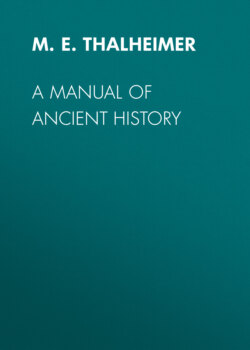Читать книгу A Manual of Ancient History - M. E. Thalheimer - Страница 14
MEDIAN MONARCHY.
Оглавление37. Little is known of the Medes before the invasion of their country by Shalmaneser II, BC 830, and its partial conquest by Sargon,[8] in 710. They had some importance, however, in the earliest times after the Deluge, for Berosus tells us that a Median dynasty governed Babylon during that period. The country was doubtless divided among petty chieftains, whose rivalries prevented its becoming great or famous in the view of foreign nations.
In Babylonian names, Nebo, Merodach, Bel, and Nergal correspond to Asshur, Sin, and Shamas in Assyrian. Thus, Abed-nego (for Nebo) is the “Servant of Nebo;” Nebuchadnezzar means “Nebo protect my race,” or “Nebo is the protector of landmarks;” Nabopolassar = “Nebo protect my son”—the exact equivalent of Asshur-nasir-pal in the Assyrian Dynasty of the Second Period.
38. About 740 BC, according to Herodotus, the Medes revolted from Assyria, and chose for their king Dei´oces, whose integrity as a judge had marked him as fittest for supreme command. He built the city of Ecbat´ana, which he fortified with seven concentric circles of stone, the innermost being gilded so that its battlements shone like gold. Here Deioces established a severely ceremonious etiquette, making up for his want of hereditary rank by all the external tokens of the divinity that “doth hedge a king.” No courtier was permitted to laugh in his presence, or to approach him without the profoundest expressions of reverence. Either his real dignity of character or these stately ceremonials had such effect, that he enjoyed a prosperous reign of fifty-three years. Though Deioces is described by Herodotus as King of the Medes, it is probable that he was ruler only of a single tribe, and that a great part of his story is merely imaginary.
39. The true history of the Median kingdom dates from BC 650, when Phraor´tes was on the throne. This king, who is called the son of Deioces, extended his authority over the Persians, and formed that close connection of the Medo-Persian tribes which was never to be dissolved. The supremacy was soon gained by the latter nation. The double kingdom was seen by Daniel in his vision, under the form of a ram, one of whose horns was higher than the other, and “the higher came up last.” (Daniel viii: 3, 20.) Phraor´tes, reinforced by the Persians, made many conquests in Upper Asia. He was killed in a war against the last king of Assyria, BC 633.
40. Determined to avenge his father’s death, Cyaxares renewed the war with Assyria. He was called off to resist a most formidable incursion of barbarians from the north of the Caucasus. These Scythians became masters of Western Asia, and their insolent dominion is said to have lasted twenty-eight years. A band of the nomads were received into the service of Cyaxares as huntsmen. According to Herodotus, they returned one day empty-handed from the chase; and upon the king’s expressing his displeasure, their ferocious temper burst all bounds. They served up to him, instead of game, the flesh of one of the Median boys who had been placed with them to learn their language and the use of the bow, and then fled to the court of the King of Lydia. This circumstance led to a war between Alyat´tes and Cyaxares, which continued five years without any decisive result. It was terminated by an eclipse of the sun occurring in the midst of a battle. The two kings hastened to make peace; and the treaty, which fixed the boundary of their two empires at the River Halys, was confirmed by the marriage of the son of Cyaxares with the daughter of Alyattes. The Scythian oppressions were ended by a general massacre of the barbarians, who, by a secretly concerted plan, had been invited to banquets and made drunken with wine.
41. Cyaxares now resumed his plans against Assyria. In alliance with Nabopolassar, of Babylon, he was able to capture Nineveh, overthrow the empire, and render Media a leading power in Asia. The successful wars of Cyaxares secured for himself and his son nearly half a century of peace, during which the Medes rapidly adopted the luxurious habits of the nations they had conquered. The court of Ecbatana became as magnificent as that of Nineveh had been when at the height of its grandeur. The courtiers delighted in silken garments of scarlet and purple, with collars and bracelets of gold, and the same precious metal adorned the harness of their horses. Reminiscences of the old barbaric life remained in an excessive fondness for hunting, which was indulged either in the parks about the capital, or in the open country, where lions, leopards, bears, wild boars, stags, and antelopes still abounded. The great wooden palace, covered with plates of gold and silver, as well as other buildings of the capital, showed a barbarous fondness for costly materials, rather than grandeur of architectural ideas. The Magi, a priestly caste, had great influence in the Median court. The education of each young king was confided to them, and they continued throughout his life to be his most confidential counselors.
42. BC 593. Cyaxares died after a reign of forty years. His son, Asty´ages, reigned thirty-five years in friendly and peaceful alliance with the kings of Lydia and Babylon. Little is known of him except the events connected with his fall, and these will be found related in the history of Cyrus, Book II.
